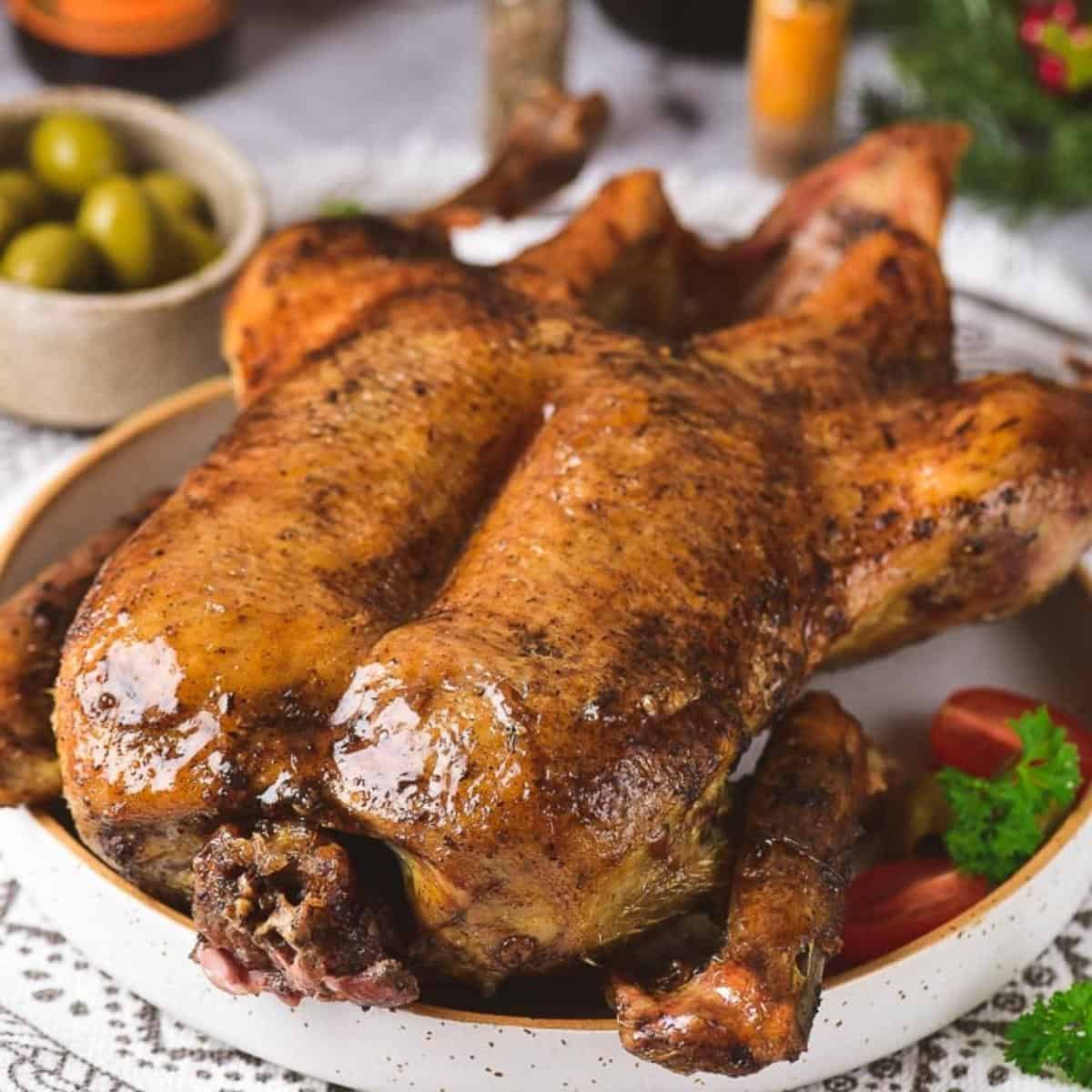
Servings: 4 people
Calories: 100kcal
Equipment
Ingredients
For The Duck
- 1 whole chilled duck
- ½ teaspoon sea salt (if duck is brined, do not add salt)
- ½ teaspoon garlic powder
- ½ teaspoon oregano, dried
- ½ teaspoon thyme, dried
- ½ teaspoon cracked black pepper
- 1 sprig rosemary, fresh
- 2 sprig thyme, fresh
For The Glaze
- ½ cup orange juice
- 2 tablespoons fig jam
- 2 tablespoons maple syrup
- 1 tablespoon soy sauce or coconut amino acids
- 1 teaspoon balsamic vinegar
- 1 tablespoon corn starch
Instructions
Brining
- Take your duck and liberally sprinkle the flesh with kosher salt. Loosely cover the duck with parchment or butcher paper and leave in the refrigerator for 24 hours. This is optional but highly recommended.
Boiling
- This is not strictly necessary but an optional step: after brining (if doing the brining step) bring a large pot of water to a boil. Boil the duck for 10 minutes if it is a younger duck, and 30 minutes if older and also pastured/free-ranged. Rest in refrigerator uncovered for 24 hours. Proceed with recipe.
Oven Roasting & Glaze
- Get all of your ingredients and equipment out. Measure out the ingredients for the glaze. Duck does not need to be brought to room temperature and can keep in the fridge until you are ready to season it.
- In a bowl, mix softened butter, salt, spices, herbs. Make a butter paste. If your duck was brined skip the salt!
- Put your duck on a large sheet of aluminum foil paper large enough to wrap it entirely. I actually prefer to put the duck on unbleached parchment paper first and then on top of the foil, but that is up to you and optional.
- Spread the butter paste on all sides of the duck inside and out. Then add the sprigs of fresh thyme and rosemary.
- Cover with foil completely and leave it alone for an hour. Preheat the oven to 400° Fahrenheit. When oven is hot and ready, uncover the duck and place it onto a roasting pan or baking sheet. Lower the heat to 350° and then bake, uncovered, for the first 30 minutes.
- After the 30 minutes are up, cover the duck BREASTS ONLY back up with the foil and continue baking until finished.
- The breasts should reach 135°F (57°C) to avoid drying out the meat. The thighs and legs should be roasted to 165°F to help break down connective tissue and produce a more tender dish. You can achieve this by keeping the breasts covered with aluminum until the end of cooking before the final broiling step.
- As the duck roasts in the oven, make the glaze: Mix everything except corn starch in a saucepan. Bring to a boil while whisking, and then lower the heat. Dissolve corn starch in a few tablespoons of water and pour into the saucepan. Simmer on low. Once the glaze has thickened, remove the saucepan from the heat.
- For the last 5 minutes of cooking time, uncover the entire duck once again, remove the sprigs of rosemary and thyme and any spices that have not melted off, and broil the skin to a final crispy perfection.
- Remove the duck and cover it with aluminum foil (or similar) without touching the skin. Allow it to rest for at least 15 minutes but preferable up to 30 minutes. This step is optional but it makes for the most perfectly cooked and juicy meat. Brush the duck with glaze and serve.
Notes
A meat thermometer is really crucial for perfectly done meat. Over cooked duck is dry, rubbery, and tough. I recommend the ThermoWorks ONE for accuracy but there are many options out there to choose from.
- Don't throw those duck bones away — make nourishing bone broth/stock! And then use the stock to make soup or a delicious risotto with porcini mushrooms, one of my favorite and best recipes.
- If this is an older pastured and free ranged duck or a wild duck you've shot — try hanging and brining the carcass first. You can read about that in my recipe and article on hanging and brining grouse.
- Try making a smoked whole duck like I show you in my recipe for smoked whole turkey and check out the Thanksgiving section on my blog for more fall favorite recipes like desserts and side dishes.
- If you're making an older duck, I do not recommend roasting. Either grind it for sausage or sauce, or turn the breasts into prosciutto, and the legs into coq au vin.
Nutrition
Calories: 100kcal | Carbohydrates: 24g | Protein: 2g | Fat: 0.2g | Saturated Fat: 0.1g | Polyunsaturated Fat: 0.05g | Monounsaturated Fat: 0.1g | Cholesterol: 0.2mg | Sodium: 561mg | Potassium: 256mg | Fiber: 1g | Sugar: 17g | Vitamin A: 170IU | Vitamin C: 53mg | Calcium: 27mg | Iron: 1mg
Tried this recipe?Let us know how it was!